
Revolutionizes research with AI summaries, citation tools, and integrity checks.
Navigating the world of academic research can be a complex and time-consuming process, but the rise of powerful AI tools is revolutionizing how scholars approach their work. Among these, SciSpace AI has emerged as a comprehensive, all-in-one research assistant designed to streamline the entire academic writing and publication workflow for researchers, students, and scientists.
Formerly known as Typeset, this platform has evolved into a robust AI-powered solution that helps you move beyond basic keyword searches to a more intelligent, semantic understanding of scholarly work. This guide provides a comprehensive overview of SciSpace’s key functionalities, from its AI-driven literature review and PDF summarizer to its citation generator and an in-depth comparison against leading alternatives like Elicit and the latest models of ChatGPT, helping you determine if this tool is the right choice to elevate your scholarly work and research papers.
What is SciSpace AI?
SciSpace AI is a powerful AI-powered research assistant designed to fundamentally change the way researchers, students, and academics interact with scholarly work. It is a comprehensive tool that moves beyond traditional search engines to provide an integrated platform for the entire academic writing and publication workflow. By leveraging advanced machine learning models, SciSpace aims to simplify complex tasks, accelerate research discovery, and enhance the quality of academic output, ultimately saving valuable time for its user base of scientists, authors, and professors.
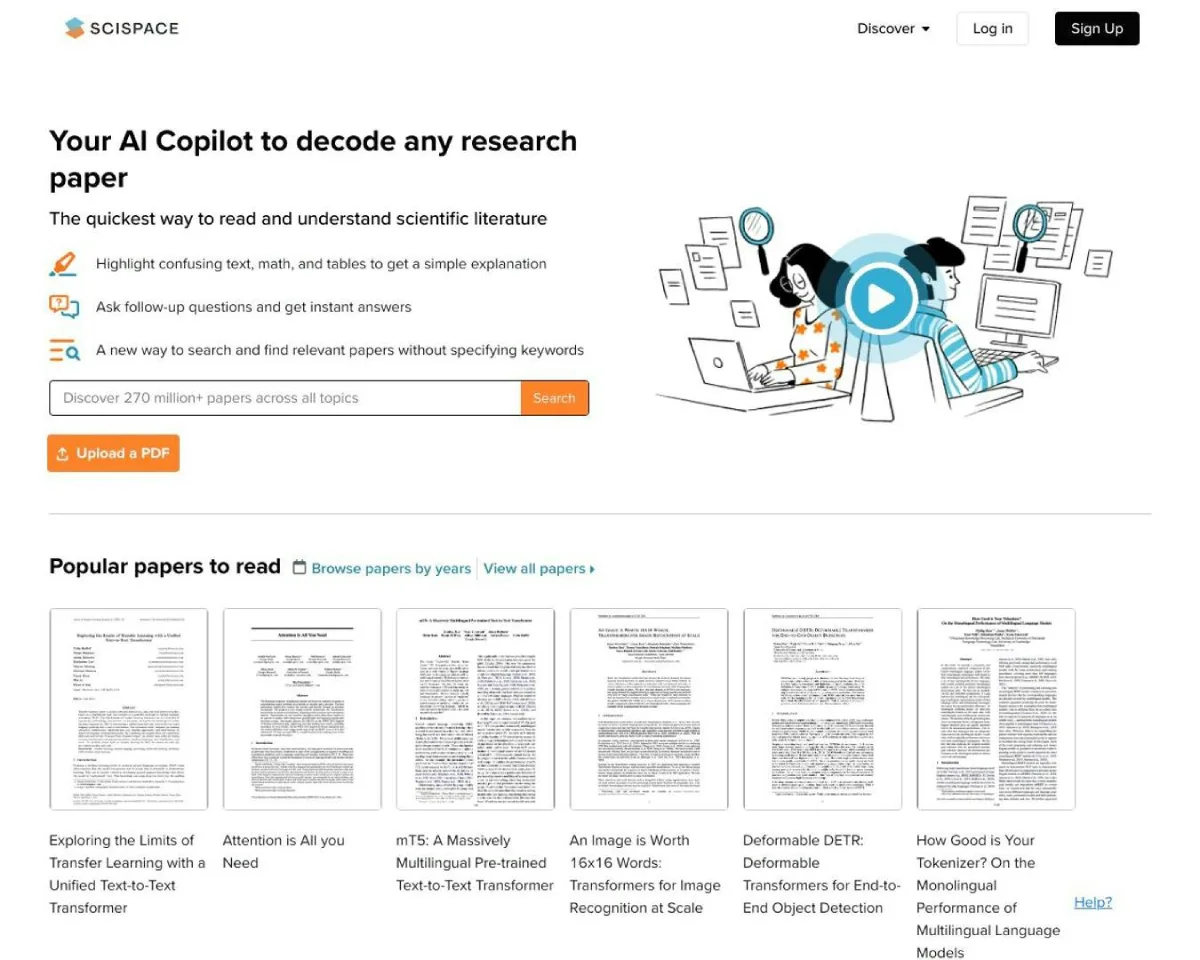
A Brief History (formerly Typeset)
SciSpace’s journey began with a different name and a more specialized purpose. Originally known as Typeset, the platform gained recognition for its innovative role as a niche formatting tool. It helped researchers quickly format their manuscripts to meet the strict guidelines of various academic journals and conferences, eliminating a common and frustrating pain point in the publication process. This foundation in practical problem-solving laid the groundwork for its evolution.
-
From a Niche Formatting Tool to an AI Research Assistant. Recognizing the broader needs of the academic community, the developers behind Typeset began to expand its capabilities. The platform was rebranded as SciSpace AI and pivoted to become a comprehensive AI-powered assistant. This strategic shift incorporated a suite of new tools that utilized artificial intelligence to assist users at every stage of their research, from initial literature review to final manuscript preparation.
The Core Purpose of SciSpace
At its heart, SciSpace’s mission is to be a single, unified platform that eliminates the need for researchers to juggle multiple disconnected tools. Its core purpose is to solve the key pain points in the research workflow by offering a seamless, end-to-end solution.
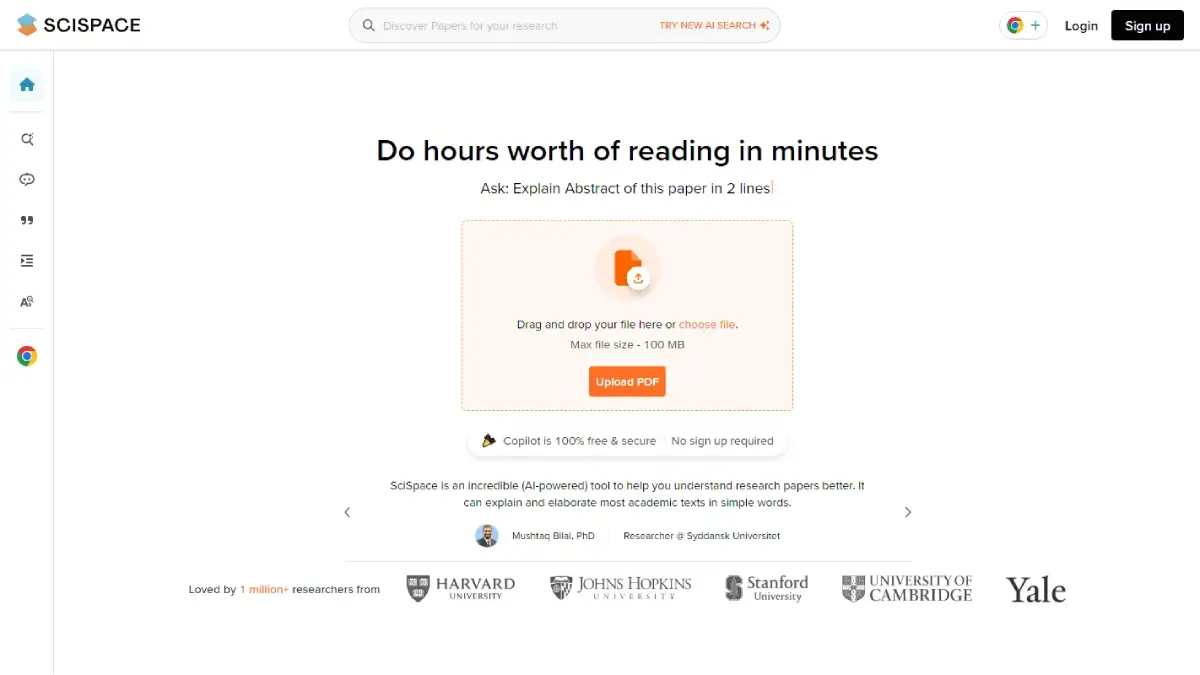
-
How it helps researchers, students, and academics streamline their workflow. SciSpace helps users in two primary ways: by automating repetitive tasks and by providing intelligent, data-driven insights. It helps students conduct systematic literature reviews, assists academics with finding research gaps, and supports scientists in drafting and refining their work. The platform’s ability to handle tasks like citation generation, PDF summarization, and paraphrasing allows users to focus on the intellectual aspects of their research rather than the mechanical ones.
-
An overview of the AI-powered functionalities. SciSpace’s key functionalities are built on a foundation of sophisticated AI technology. It includes a semantic search engine that understands natural language queries, a Chat with PDF tool that allows for interactive analysis of scholarly papers, and a robust AI Writer to assist with drafting. Other essential features include a plagiarism checker and a citation generator, all working in concert to provide a powerful and cohesive academic tool.
Deep Dive into SciSpace’s Core Functionality
SciSpace AI’s power lies in its comprehensive suite of tools, which are all interconnected to create a seamless research workflow. Instead of being just a singular feature, its strength is in combining AI-powered academic writing tools with an expansive, up-to-date database of over 280 million research papers.
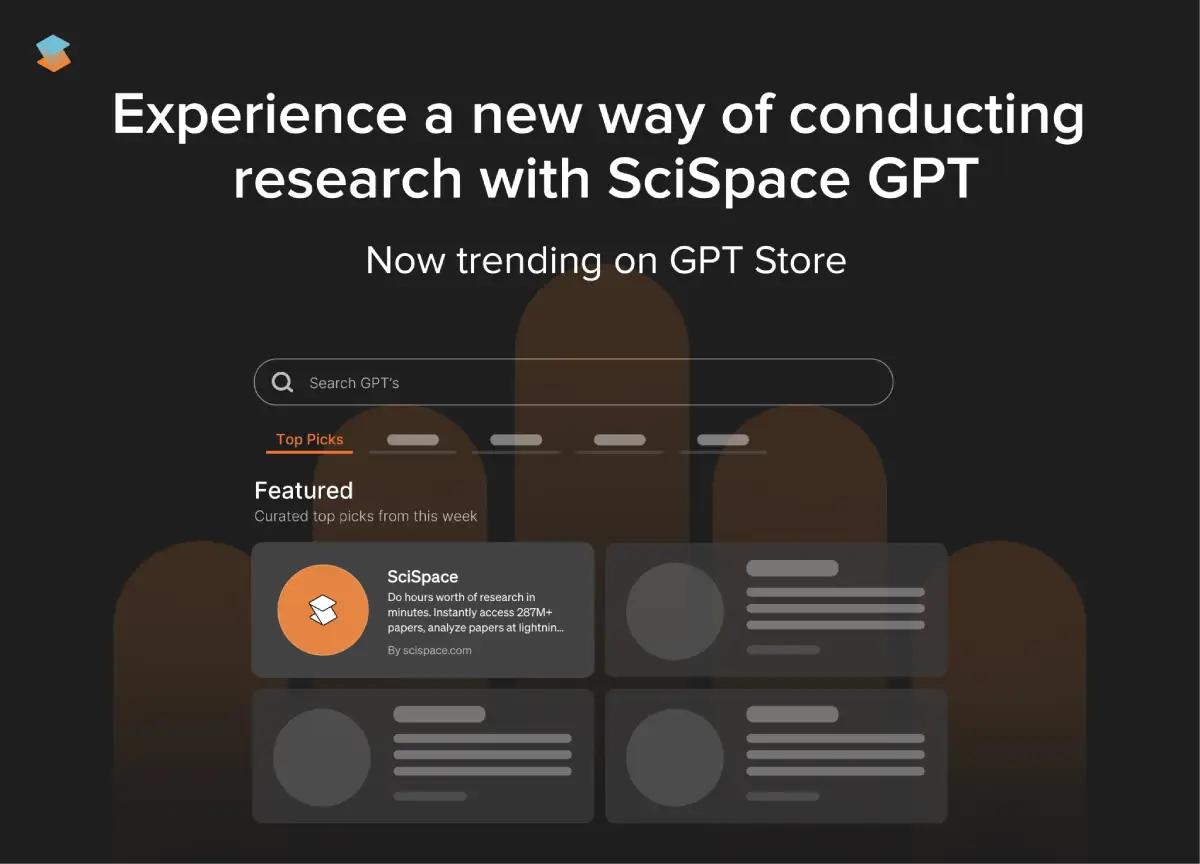
AI Literature Review & Semantic Search
For many researchers, the most time-consuming task is the literature review. SciSpace’s AI-powered system revolutionizes this process by going beyond simple keyword matching.
-
“How to conduct a literature review with AI.” You begin by entering a natural language query, such as “What are the latest applications of AI in cancer detection?” The AI then analyzes your intent and searches for the most relevant scholarly work, providing a quick summary and key takeaways. You can then use the platform’s tools to filter, save, and organize the most pertinent papers, building a structured evidence base for your research.
-
Using natural language questions for better research results. Traditional search engines often fail to grasp the nuance of a query. SciSpace’s semantic search, however, understands the relationships between concepts, synonyms, and context. For example, a query about “solar panels” might also return results on “photovoltaic cells” or “renewable energy technologies,” giving you a more complete picture without having to manually refine your search.
-
The role of Latent Semantic Indexing (LSI) in SciSpace’s search engine. Latent Semantic Indexing is a core component of this. It helps SciSpace understand the underlying themes and concepts of a document, not just the keywords. This allows the tool to discover connections that may not be immediately obvious, helping you find foundational studies, identify research gaps, and track the evolution of a topic with greater accuracy.
AI Writer: Your Academic Content Generator
SciSpace’s AI Writer acts as a drafting assistant for manuscript preparation, helping researchers translate complex ideas into polished, academic text.
-
“Best AI tool for writing a research paper.” While no AI can replace human expertise, SciSpace’s AI Writer is designed to be a highly effective partner. It is trained on a vast corpus of scientific literature, giving it the ability to generate academically sound content and suggest edits that are appropriate for scholarly publications.
-
Features like paraphrasing, editing, and content completion. The tool offers a range of features to support your academic writing. The paraphrasing tool helps you rephrase sentences while maintaining the original meaning. The editing function checks for grammar, style, and clarity, ensuring your manuscript is professional. Additionally, its content completion feature can suggest logical continuations to your sentences and paragraphs, helping you overcome writer’s block.
Chat with PDF & PDF Summarizer
SciSpace’s interactive PDF tools are invaluable for quickly extracting insights from research papers.
-
How to interact with scientific literature and get instant answers. You can upload any PDF and have a conversation with it. Instead of reading through a 70-page paper, you can ask direct questions like, “What was the main hypothesis of this study?” or “What data did they use?” The AI will respond with a summarized answer, often citing the exact section of the paper it pulled the information from. This feature is a game-changer for speeding up literature analysis.
Citation Generator & Reference Management
Maintaining a perfect bibliography is critical for academic integrity, and SciSpace simplifies this often tedious task.
-
How SciSpace simplifies bibliography creation. The citation generator automatically creates in-text citations and bibliographies in thousands of formats, including APA, MLA, and Chicago. You can easily export these references, ensuring your manuscript is publication-ready and accurately formatted. This feature significantly reduces the risk of referencing errors.
Plagiarism and AI Detection
In an era of increasing AI use, ensuring originality has become a top priority. SciSpace offers tools to help authors, students, and academics maintain integrity.
-
“What is SciSpace’s AI detector?” SciSpace’s AI detector is a tool specifically trained to identify AI-generated content. It works by analyzing the text’s sentence structure, word patterns, and overall style, which often differ from human writing. It can analyze both text pasted directly into the tool and content uploaded as a PDF.
-
The importance of originality in scholarly work. While AI can be a powerful assistant, it should never replace the author’s original thought and contribution. SciSpace’s AI detector serves as a final check to ensure that the content submitted for academic publication or assignment is genuinely your own and adheres to the principles of academic integrity.
Other Essential Research Tools
Beyond its core functionalities, SciSpace includes a variety of other features that further enhance the research workflow.
-
Data extraction, AI-powered notebooks, and manuscript preparation. The platform allows you to extract key data points from papers into a structured format. Its AI-powered notebooks help you organize your research insights and notes in a central location. Finally, its templates for manuscript preparation ensure your work is formatted correctly before you even begin writing.
SciSpace vs. The Competition: A Head-to-Head Comparison
In the rapidly evolving landscape of AI for academic work, SciSpace doesn’t exist in a vacuum. A user with commercial investigation intent will invariably compare it to other platforms. To provide a comprehensive and trustworthy analysis, we conducted a head-to-head comparison against its leading competitors, evaluating each tool’s strengths, weaknesses, and ideal use cases.

SciSpace vs. ChatGPT for Academic Research
While both are powerful AI tools, SciSpace and ChatGPT are fundamentally different in their purpose and application. This is a critical distinction for researchers seeking a reliable academic assistant.
-
Strengths of SciSpace’s academic-specific database vs. ChatGPT’s general knowledge. ChatGPT, even in its most advanced versions like GPT-4o and the rumored GPT-5, is a general-purpose large language model. Its vast knowledge is scraped from the entire internet, making it excellent for brainstorming, drafting general content, and summarization. However, it lacks a curated, verifiable database of scholarly literature. This can lead to “hallucinations”—where the AI generates plausible-sounding but factually incorrect or fabricated citations and information. SciSpace, in contrast, is an AI-powered tool specifically trained on a massive, verified database of over 280 million research papers, giving it an unparalleled advantage in factual accuracy and academic integrity. Its outputs are consistently grounded in real scholarly work, making it the more reliable choice for producing a manuscript or literature review.
SciSpace vs. Paperpal & Jenni AI
SciSpace, Paperpal, and Jenni AI all compete in the academic writing and research space, but they each have a unique focus that appeals to different types of users.
-
Comparing features, target audience, and ease of use. Paperpal is a robust, all-in-one academic toolkit that excels in post-writing checks. It offers real-time language enhancement, plagiarism detection, and journal-specific formatting. Its primary strength lies in polishing a paper for submission, making it an ideal tool for researchers nearing the final stages of their manuscript.
Jenni AI, on the other hand, is a writing co-pilot with a seamless, minimalist interface. Its core strength is its ability to auto-complete paragraphs and suggest content in real time, helping writers overcome writer’s block without disrupting their flow. Jenni is perfect for authors who want a subtle, integrated AI assistant rather than a comprehensive research platform.
SciSpace stands out as the all-in-one research platform. It combines a powerful literature review engine, a versatile writing assistant, and other essential tools like a citation generator and a PDF summarizer. Its strength lies in its end-to-end functionality, catering to researchers from the very beginning of their project to the final stages of publication.
SciSpace vs. Elicit & Semantic Scholar
These platforms are all well-regarded in the academic community, but they cater to different stages of the research process.
-
How SciSpace stands out as a comprehensive tool. Semantic Scholar is an excellent, completely free academic search engine that uses AI to map connections between papers, authors, and topics. It’s a powerful discovery tool but lacks the writing and management features of a comprehensive platform. Elicit is a specialized tool that excels at data extraction and the initial stages of a literature review. It’s renowned for its ability to quickly synthesize key findings from multiple papers into a table, which is a significant time-saver. However, Elicit is not designed for manuscript drafting or citation management. SciSpace, in contrast, integrates the search and discovery capabilities of Elicit and Semantic Scholar with a full suite of writing and publishing tools, making it a more comprehensive and holistic solution for the entire research workflow.
SciSpace vs. Google Scholar
For decades, Google Scholar has been the go-to resource for academic search. However, the rise of AI-powered tools like SciSpace presents a new, more intuitive way to discover and engage with academic literature.
-
The advantages of AI-powered semantic search over traditional keyword search. Google Scholar relies on a traditional keyword-based search. You must use precise keywords and Boolean operators to find what you’re looking for. While effective for a known-item search, this approach can be cumbersome for exploratory research. SciSpace’s AI-powered semantic search understands the context and meaning of a query. This allows you to ask natural language questions like “What are the long-term effects of social media on mental health?” and receive highly relevant, context-aware results. This intelligence makes SciSpace not just a search engine, but a genuine research assistant, transforming the user experience from a simple search-and-find to an interactive discovery process.
SciSpace Pricing, Plans & Accessibility
A crucial part of any user’s decision-making process is understanding a product’s cost and how to access it. SciSpace is designed with a flexible pricing model to cater to a wide range of users, from individual students to large research institutions. This section breaks down the costs, features, and key access points to help you make an informed choice.
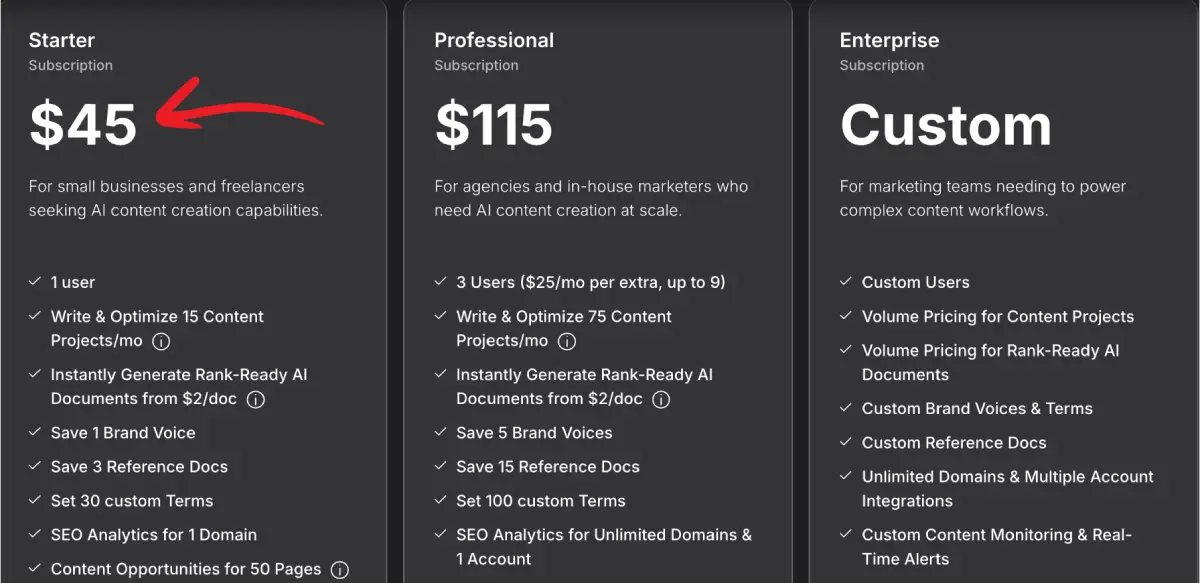
SciSpace Free Trial vs. Premium Features
SciSpace offers a “freemium” model, which provides a risk-free way for new users to explore its capabilities. This is a deliberate strategy to attract students and academics who need to test the tool’s effectiveness before committing financially.
-
A breakdown of what’s included in each plan. The Free Plan is a great starting point. It allows for a limited number of literature review searches, AI actions in the AI Writer, and chats with PDFs. While this plan provides a solid introduction to the platform’s core functionalities, it comes with restrictions on the number of searches, outputs, and the quality of the AI model you can access.
The Premium Plan unlocks the full potential of SciSpace. It provides unlimited access to all AI tools, including comprehensive literature review searches, unlimited AI actions, and unrestricted use of the Chat with PDF feature. Premium users also benefit from access to high-quality AI models, unlimited citation generation, and the ability to export data in various formats (e.g., RIS, CSV, BIB). This plan is ideal for individual researchers, Ph.D. students, and professionals who rely heavily on the tool for their ongoing scholarly work.
-
“SciSpace AI pricing for universities” and team plans. For larger groups, SciSpace offers specialized plans tailored to the needs of educational and research institutions. These Labs & Universities plans provide a discounted, per-user-per-month rate, which is often significantly lower than the individual premium plan. These subscriptions come with added benefits like dedicated customer success managers, enhanced security, and role-based management for administrators. This structure ensures that entire departments or research teams can utilize the platform’s full power collaboratively and at a reduced cost.
Who Should Use SciSpace?
SciSpace is an AI-powered academic assistant with a broad appeal, but its true value is unlocked when tailored to specific user needs. While the tool is built for anyone involved in research, its comprehensive feature set provides distinct benefits for different segments of the academic community, from undergraduates to seasoned professionals.
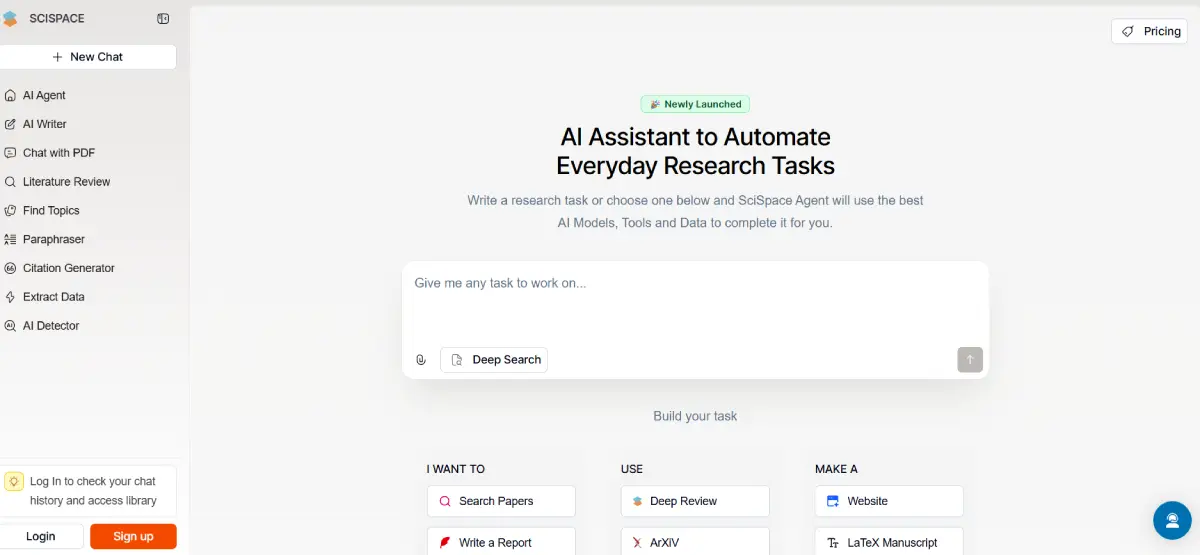
SciSpace AI for Students vs. Researchers
The functionality of SciSpace remains the same, but the way students and seasoned researchers leverage it often differs based on their goals and experience. For a student, the platform is an invaluable learning aid. They use it to grasp complex concepts, simplify dense academic language, and structure their first-ever literature review or research paper. SciSpace acts as an educational co-pilot, guiding them through the foundational stages of scholarly work.
In contrast, an established researcher or scientist uses SciSpace not for foundational learning, but for a massive boost in efficiency. They rely on the platform to save hours on repetitive tasks like data extraction from dozens of papers, systematic literature reviews, and manuscript preparation. For them, SciSpace is a strategic tool for accelerating their research workflow and increasing their productivity, allowing them to focus on critical analysis and innovation.
A Use-Case Summary for Each User Base
-
Students: For Literature Review and Writing Assistance. For students, SciSpace is the ideal tool for navigating the often-intimidating world of academic research. They can use the AI-powered literature review to quickly identify relevant sources and understand key concepts. The Chat with PDF feature is a game-changer for essay and thesis writing, as it allows them to interact with a handful of papers and get instant answers to their questions, simplifying complex ideas and breaking down jargon. The citation generator ensures their bibliographies are flawlessly formatted, saving them from common errors and helping to maintain academic integrity.
-
Researchers: For Manuscript Preparation, Data Analysis, and Publication. Researchers, professors, and professionals in academia find immense value in SciSpace’s advanced capabilities. They can run a systematic literature review using the deep search functionality, which can analyze hundreds of papers to identify research gaps and key trends. The data extraction tool is critical for tasks like meta-analysis, allowing them to pull specific data points (e.g., methodologies, results, sample sizes) from multiple PDFs into a single, organized table. For publication, they use the AI Writer for drafting, editing, and ensuring their manuscript adheres to specific journal submission templates.
-
Authors & Scientists: For a Streamlined Research Workflow. For authors and scientists working in fast-paced fields, time is a critical resource. SciSpace serves as an end-to-end platform that streamlines their entire research workflow. From the initial idea generation with AI-powered topic finders to the final stages of a scientific paper, they can rely on one cohesive tool. This includes using the platform to find and analyze the latest scientific literature, organize their insights in AI-powered notebooks, and prepare their final manuscript for publication, ensuring their work is both accurate and efficient.
Conclusion: Is SciSpace the Right Tool for You?
After a deep dive into its core functionalities, competitive advantages, and pricing structure, the question remains: is SciSpace the right AI-powered research assistant for your needs? Our final verdict is that SciSpace stands out not as a single-purpose AI tool, but as a comprehensive, end-to-end platform that addresses the entire academic workflow. It provides a unique balance of powerful research discovery and practical writing assistance, making it a valuable investment for serious scholarly work.
Final Verdict and Recommendations
For students, SciSpace is a powerful educational and writing assistant. Its Chat with PDF and literature review tools are invaluable for simplifying complex topics and structuring essays. If your primary needs are to understand research papers and efficiently write assignments, SciSpace provides a robust, all-in-one solution that helps you master the fundamentals of academic research.
For professional researchers and scientists, SciSpace is a true productivity accelerator. Its ability to perform a systematic literature review, extract data from multiple papers, and provide a dedicated workspace for manuscript preparation saves countless hours. While competitors like Elicit and Semantic Scholar excel at specific tasks, SciSpace’s strength lies in its ability to keep your entire research workflow within a single, trusted environment. If you are looking to streamline your process from discovery to publication, the Premium Plan is a highly worthwhile investment.
For those considering a comparison, our analysis shows that SciSpace provides the factual grounding and academic rigor that a general-purpose AI like ChatGPT lacks, while offering a more comprehensive toolkit than specialized platforms like Paperpal.
A Look at the Future of AI in Academic Research and Publishing
The role of AI in academia is evolving at a breakneck pace. As of late 2025, the conversation has shifted from “if” to “how” AI should be integrated. Tools like SciSpace are at the forefront of this transformation. The next wave of innovation will likely focus on even greater integration, with AI agents capable of not just assisting but autonomously managing research tasks, from drafting entire sections of a paper to identifying the perfect journal for publication.
The future of academic publishing, according to industry experts, is a hybrid, human-led, AI-augmented model. While AI will continue to improve at automating tedious tasks like data analysis, citation management, and language refinement, the human role in critical thinking, ethical judgment, and creative insight will become even more crucial. Platforms like SciSpace are paving the way for a future where academics are empowered by intelligent tools, not replaced by them, allowing for faster scientific breakthroughs and a more efficient, accessible research landscape.
Featured AI Tools
Submagic makes your short-form videos captivating with AI captions, b-rolls, and smart edits. Save time and grow your social media reach effortlessly.
Create AI videos from text, photos, audio, slides, and more using KreadoAI’s media assets, effects, and stickers. Instantly turn your ideas into stunning
Transform your ideas into stunning videos with our AI video generator. Easy to use Text to Video editor featuring lifelike voiceovers, dynamic AI video clips.
Elevate your content with Boolvideo: Turn your resources into engaging videos easily! Drive leads, boost sales, amplify reach with the AI Video Generator.




